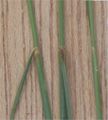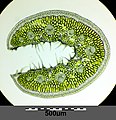Sheep fescue
| Sheep fescue i. w. S. | ||||||||||||
|---|---|---|---|---|---|---|---|---|---|---|---|---|

Sheep fescue ( Festuca ovina ) |
||||||||||||
| Systematics | ||||||||||||
|
||||||||||||
| Scientific name | ||||||||||||
| Festuca ovina agg. | ||||||||||||
| L. |
The term sheep-fescue describes the very heterogeneous, multi-shape sheep-fescue group ( Festuca ovina agg.) (= Collective species ) belonging to the sweet grasses (Poaceae ). It includes closely related clans ( taxa ) which are very similar in shape and which can be differentiated according to the time of blooming, various differences in leaf and flower characteristics, and according to their ecological preferences and their geographical distribution.
distribution
The sheep fescue is distributed differently across Europe , temperate Asia , North Africa and North America , depending on the clan .
description
The types of the group are herbaceous plants of several years . The grasses reach heights of up to 60 centimeters. They are dense clump- shaped growth with bristly to rush-shaped, tightly folded leaves . They are light to dark green, frosted blue-gray or not frosted (wipeable wax layer). The leaf sheaths are in contrast to the collective species Festuca rubra agg. closed at most in the lower third. The ligule are short and inconspicuous. Small round auricles are developed at the transition from the leaf sheath to the leaf blade .
The panicles are up to 12 centimeters long. They are contracted before and after flowering. The panicle branches stand upright. The lowest branch reaches about a third of the length of the panicle. The spikelets are oblong-ovate and tinged with green to purple. They are three to eight flowered. The glumes are narrowly lanceolate and ciliate on the keel. The lemmas are awned or awned. The flowering period extends from April to October, but varies depending on the clan.
The characteristics vary widely within the different clans and there are numerous transitions, so that a determination is not infrequently difficult. In the meantime, good identifying features such as leaf cross-sections and vascular bundles and sclerenchymal cords (cord-like reinforcing tissue) that can be seen in them have been developed.
Small types
The list of species is based on an adaptation by E. Patzke & GH Loos and includes a complex of very similar, in part still undescribed clans.
| German name | Scientific name | Habitats |
|---|---|---|
| Valais sheep fescue | Festuca valesiaca Schleich. ex Gaudin | semi- arid subcontinental grasslands |
| Fake sheep fescue | Festuca pulchra Schur | Subcontinental semi-arid lawns, shear and park lawns, short-lived ruderal corridors , sheet piling |
| Furrow sheep fescue | Festuca rupicola hay. | Rock band lawns on limestone, dry and semi-dry lawns, semi-rudimentary couch grass, dry land areas, embankments without trees, soil extraction areas |
| Siebennerviger-Furchen-Sheep-Fescue | Festuca sulcatiformis ( Margram-Dann. ) Patzke & GH Loos | Ledge lawn on lime |
| Predatory sheep fescue | Festuca brevipila R. Tracey | Ledge corridors, dry and semi-arid grasslands, short-lived ruderal corridors, shear and park lawns, railroad areas, embankments without wood, wasteland and fallow land , excavation areas |
| Duval's sheep fescue | Festuca duvalii ( St. Yves ) Stohr | Feather grass steppe lawns , blue schiller grass sand steppes |
| Real sheep fescue | Festuca ovina L. | abgetorfte surfaces, ground oak acidic mixed forests, coniferous forests , dwarf-shrub , lean lawn , Ephemeral Ruderalfluren, traffic routes, wasteland and municipal waste land, Wild warehouses |
| Awnless sheep fescue | Festuca filiformis Pourr. | Acid mixed oak forests , coniferous forests , rocky lawns, sandy grasslands, bristle grazing in the lowlands on dry locations, short-lived ruderal meadows, traffic routes, wasteland and fallow land |
| Patzke's sheep fescue | Festuca patzkei Markgr.-Then. | heat-loving silicate rock grass lawns, rock band lawns |
| Hungarian sheep fescue | Festuca pannonica Wulfen ex host | Rock lawn |
| Smooth sheep fescue | Festuca laevigata margram-then. | Drought-bearing upholstered sedge and blue-grass eyrie sedge grass, rock grass, dry and semi-dry grass |
| Little sheep fescue | Festuca airoides Lam. | Bärwurz grasslands , montane and alpine grasslands |
| Tough sheep fescue | Festuca guestfalica Boenn. ex Rchb. | Oak-hornbeam forests, heat-loving mixed oak forests, dry pine forests, dry and semi-arid grasslands, oat valley meadows, dry lime-whistle grass meadows, herbaceous meadows and edges of dry locations, short-lived ruderal meadows, traffic routes, wasteland and fallow land |
| Galmei sheep fescue | Festuca aquisgranensis Patzke & GKBr. | Heavy metal lawns , Galmeifluren |
| Léman's sheep fescue | Festuca lemanii bastard | Lean sand lawns, sheet piling |
| Long-leaved sheep fescue | Festuca longifolia Thuill. | Silver grass fields of open drifting sands |
| Rough sheep fescue | Festuca heteropachys ( St.-Yves ) Patzke ex Auquier | Rock grass, sandy grassland |
| Pale sheep fescue | Festuca pallens host. | Rock band lawns, acidic dry lawns |
| Dune sheep fescue | Festuca polesica Zapal. | Coastal sand schiller grass lawns, grass carnation corridors, silver grass corridors of open drifting sands, blue schiller grass sand steppes |
| Sand sheep fescue | Festuca psammophila ( Hack. Ex Čelak. ) Fritsch | Blue schiller grass sand steppes, short-lived ruderal meadows |
| Sheep fescue | Festuca vaginata Waldst. & Kit. ex Willd. | Blue grass sand-steppes |
use
Sheep fescue mostly occurs in extreme locations where more demanding forage grasses no longer thrive and they cannot be displaced by them. Even sheep are reluctant to eat them. The hay is also considered to be inferior. Sheep fescue often hampers the exchange of water and air in the soil with its dense stand and poorly decomposable residues. However, it is recommended as an undergrass for sunny, dry locations on nutrient-poor soils. The type in seed mixtures is also important for stabilizing the ground on dry slopes and embankments.
See also
- Red fescue ( Festuca rubra agg.)
swell
literature
- Jürke Grau , Bruno P. Kremer, Bodo M. Möseler, Gerhard Rambold, Dagmar Triebel: Grasses. Sweet grasses, sour grasses, rushes and grass-like families in Europe (= Steinbach's natural guide ). New, edit. Special edition edition. Mosaik, Munich 1996, ISBN 3-576-10702-9 .
- Jürgen Dengler: Standard list of the narrow-leaved fescue family (Festuca ovina agg. And F. rubra agg.) In Germany. Lüneburg 2000, PDF file.
- MJ Wilkinson, CA Stace: A new taxonomic treatment of the Festuca ovina L. aggregate (Poaceae) in the British Isles. In: Botanical Journal of the Linnean Society. Volume 106, No. 4, 1991, pp. 347-397, DOI: 10.1111 / j.1095-8339.1991.tb02298.x .
Individual evidence
- ^ Henning Haeupler, Thomas Muer: picture atlas of the fern and flowering plants of Germany . Ed .: Federal Agency for Nature Conservation (= The fern and flowering plants of Germany . Volume 2 ). Eugen Ulmer, Stuttgart (Hohenheim) 2000, ISBN 3-8001-3364-4 , pp. 663-667 .
- ^ Ernst Klapp , Wilhelm Opitz von Boberfeld : Pocket book of grasses . Recognition and determination, location and socialization, evaluation and use. 12th revised edition. Paul Parey, Berlin / Hamburg 1990, ISBN 3-489-72710-X .









